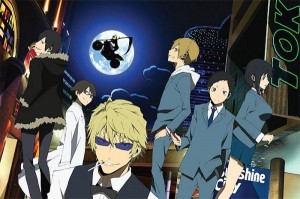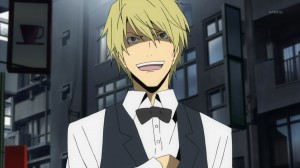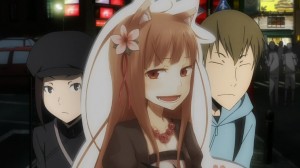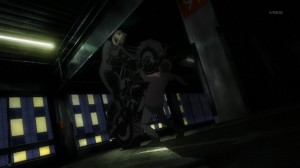
It’s not often I get the opportunity to watch a series with a complicated story and deep character relations. I’ve known about Durarara!! for quite some time, but only now have I taken the time to watch this fantastic series. I can only say the anime deserves every bit of praise it is given, and provides viewers who enjoy “plot” and “story-driven progression” a phenomenal time.
At first, I was under the impression that the story would be hard to follow. The first episode introduces the viewer to a plethora of characters, and it can seem like a lot of information to process and remember. However, the introduction also allows the viewer to experience the same feelings the main character, Mikado, experiences. In a way, it’s a clever method of introducing a wave of information without losing the viewer. In addition, while the viewer may not be able to follow everything at the very beginning, as details are leaked out and revealed the previous scenes may be better understood and make the viewer view past events in their entirety. For example, as I enjoyed the series I failed to understand the events in full light until a few episodes after, some not being completely understood until near the ending of the series. However, the show grasps the viewers attention and brings excitement and reason to continue the series.

The show can be easily divided into two arcs, with each splitting the episode count near evenly. The first arc really focuses on Mikado’s transition into the big city life, while also introducing the viewer to the vast selection of characters focused on in this series. However, this arc really focuses on Mikado Ryugamine, the transfer student “main” character, “The Black Rider,” who is rumored to be headless, and Shinra Kishitani, a black market surgeon who lives with “The Black Rider.” The truth to unveil the “Black Rider’s” past is underway, and the road there proves to be a difficult one that involves nearly every character in the series. If there is one remark I can make about the characters in this series, there are no characters in this series that have little to no significance. I love the way the characters all interact and have some bond with another. Perhaps it’s my attraction to well tied plot, or even just the lack of nonsense, but the completion of it all really compliments the series as a whole.
The second arc revolves around the main character, Mikadono Ryugamine, and his two friends, Masaomi Kida and Anri Sonohara. This arc tests the limits of their friendship and reveals the twisted past they each hold. This chapter provides a large boost of character development for these characters, as well as some other minor characters, but those who held the spotlight in the previous arc will take the backseat and provide only supporting roles for this chapter. Of course, every character tends to get some screen time, and their appearances all flow together seamlessly.

Luckily, the series doesn’t consider itself serious at all times. The comedy in this series is used sparingly and wisely, which only adds to the series as a whole. Due to its nature as a story-driven series, the comedy proves to be a valuable asset and escape from the story as a whole. In addition, the amount of references to other anime this series makes is amazing and caught me off guard. When I first saw Horo from Spice and Wolf, I started cracking up. It only got better as these references grew and I found myself grinning whenever there was a reference that I caught on. However, when it’s time to get serious, the series knows when to kick it into gear and commence the story.

The opening and ending credits used in this series greatly compliment the stylistic choice of this series. The opening songs get the viewer “pumped up” for the current episode, while providing a quick recap of the previous episode that relates to the current episode. It’s an excellent technique that proves beneficial to those who are watching episodes separately and not in a quick succession. The endings don’t add to much to the series, but they don’t detract from the series, and I think that’s the most important aspect an ending credit sequence should have.
Unfortunately, this series isn’t flawless. This story, as far as the anime is concerned, isn’t complete. Various aspects which were uncovered during the progression of the anime were left open, and many had yet to be concluded. In short, one could say the ending left much to be desired, and while it wasn’t terrible by any stretch of the imagination, there are many missing pieces in this puzzle, and only wish to be filled in at a later time.
By these details alone, Durarara!! will give any fan of story-driven anime a great time, and should be viewed at least once. The animation is swell, the music only adds to the experience, and the characters, all unique and fascinating, create a sense of reality in this fantasy supernatural world. I won’t give a score, as this was merely my experience after watching the entirety of the series, but I can say that my impressions after the series was over was a positive one.